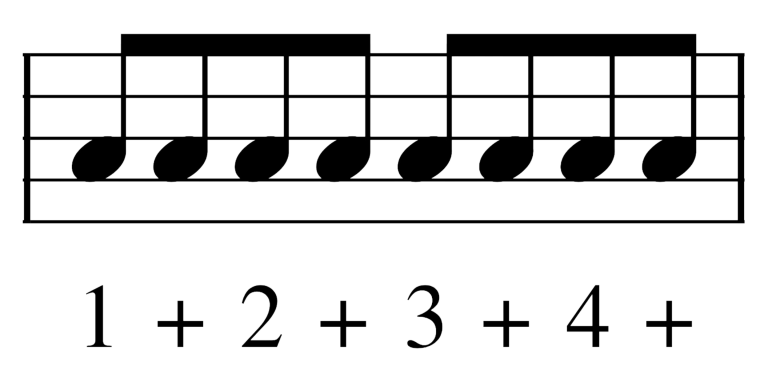Free Online Metronome
Free Online Metronome
66%
How to Use the Free Online Metronome
1. Select Your Tempo
Choose a comfortable BPM (Beats Per Minute). It is best to practice rhythms slowly so that you can make sure you hit every note perfectly. When you get advanced, you can see how low of a BPM you can go!
2. Select Your Subdivision
Choose from quarter notes, eighth notes, sixteenth notes and triplets.
3. Select Your Time Signature
For most types of music (especially contemporary), this will be in 4/4. To understand time signatures better, please read the article below.
4. Choose Swing of Straight
By default, it is set as straight, and the single bar won’t affect anything. However, when you tick the button, swing is then enabled, and you can change the percentage!
4. Play Along
Have something to play along to the metronome, take your time, slow things down and enjoy yourself!
How to Use the Free Online Metronome
1. Select Your Tempo
Choose a comfortable BPM (Beats Per Minute). It is best to practice rhythms slowly so that you can make sure you hit every note perfectly. When you get advanced, you can see how low of a BPM you can go!
2. Select Your Subdivision
Choose from quarter notes, eighth notes, sixteenth notes and triplets.
3. Select Your Time Signature
For most types of music (especially contemporary), this will be in 4/4. To understand time signatures better, please read the article below.
4. Choose Swing of Straight
By default, it is set as straight, and the single bar won’t affect anything. However, when you tick the button, swing is then enabled, and you can change the percentage!
4. Play Along
Have something to play along to the metronome, take your time, slow things down and enjoy yourself!
What is a Metronome?
A metronome is a tool that can help you master your rhythms and make you sound better. You can develop your sense of time and your internal subdivision grid by playing along at a consistent rate set by a metronome. So how does it work? The metronome produces clicks at a steady rate, and some musicians perhaps regard this as perfect timing as the beats will always land in the same place every time! Your goal is to nail every beat as it comes along.
In most metronomes, you can select how fast or slow you want to practice your timekeeping, and this is called setting your BPM. BPM stands for beats per minute, so-called because if the beats carried on at the same rate for a minute, they would produce a measurable unit (i.e. 100 BPM would produce 100 beats per minute).
Old metronomes used to involve a pendulum swinging back and forth, and these physical metronomes did have the possibility of breaking, causing musicians to play strange tempo accelerations (like Beethoven, who supposedly used a broken metronome!). You may see these metronomes still knocking about in recording studios, where they can act as a great visual indication for musicians, and particularly drummers who usually have to record their drums first when building up a track.


Understanding Time Signatures and Rhythms
Our metronome online can be a great way to introduce and train a musician with rhythm note lengths. First, set the metronome to its default setting, 4/4 and in quarter notes. This is easy to grasp as you play on every beep and count 1,2,3,4.
We can subdivide these quarter notes into eighth notes. We can do this by counting 1+2+3+4+. In my free online metronome with subdivisions, you can select the eighth note function and actively hear where these subdivisions are.
Sixteenths
We can then do this a step further by dividing those eighth notes into sixteenth notes.
We can count these subdivisions by thinking 1 e + a 2 e + a 3 e + a 4 e + a.
You can select this function by clicking on the sixteenth note button.
As you start to get familiar with the subdivisions, set the metronome to play on the beats, and practice playing the subdivisions without the aid. You also practice particular rhythms. For instance, say that you’re always going to play the + of 2 every bar. Or even a group of rhythms like the (4) e + a.

A Metronome is There to Help You Know Where the Subdivisions Are!
- The top number represents the number of beats.
- The bottom number represents the note length of those beats.
How to Understand Time Signatures
In my free online metronome, you can select the time signature to suit your needs. The most widely consumed music is in 4/4 (four to the floor!) as it provides a straightforward, steady rhythm that’s easy to grasp. This is the time signature you will be playing (and hearing) the majority of the time.
Lets Practice
The top number is easy to grasp as it just determines the number of times to count per bar. The bottom number is less easy to grasp as you need to know what numbers are associated with each note length.
1 = A whole note/semibreve
2 = A half note/minum
4 = A quarter note/crotchet
8 = An eighth note/quaver
16 = A sixteenth note/semiquaver
For instance, the time signature 12/8 will have a bar made up of 12 eighth notes (quavers). A time signature of 15/16 will have a bar made up of 15 sixteenth notes (semiquavers).




Free Online Metronome Practice Tips
The best tip I can give you is to be critical of yourself. The whole point of playing along to a strict tempo is that it will never change, making it easy for you to hit the right note you’re targeting. Take it slow and be precise! To make it harder, slow the tempo further down and really try to hit the notes precisely. When you become really, really good, you can do what all professional musicians can do: decide the feel of the notes. You can do this by playing the beats pushed (slightly ahead to give an energetic feel) or pulled (slightly behind to provide a more relaxed feel). This ‘feel’ and knowledge of note placement is what makes all great musicians, especially rhythm players. Sometimes it is best to keep your playing simple and focus on getting the simple things right. You can even say that you want to play specific beats pushed and some pulled, and you can experiment with this in a groove!
Another tip would be to experiment with different articulations. For instance, pizzicato (short note length) and tenuto (full note length) and really try to understand these articulations.
The End Goal
When we put all these techniques together, we can develop a great ‘in the pocket’ groove!
The only other advice I would give is to listen to great musicians and music. Watch this fabulous video below that demonstrates great music at work, Chocolate Souffle by Oz Noy. Featuring world class musicians Vinnie Colaiuta on Drums, John Patitucci on Bass, Brian Charette on keys and of course, Oz Noy on guitar!

Who's In charge of Rhythm in a Band?
If you were only thinking of the drummer, you’d be wrong!
Everyone in the band is responsible for rhythm and time keeping!
The rhythm, groove and feel of a song depend on what it is about and what emotions the musical piece is supposed to express. So it depends on who first sets the mood of a piece that determines its feel. If a piano starts, then the drummer may decide to go off the feel of the pianist than just go in doing their own thing and competing against it.
Anyway, these are all things you learn about when getting into a room with a bunch of musicians and playing with each other. So whilst playing along to a metronome is hugely beneficial, it is only meant to prepare you for when playing with a group of musicians.
An important thing to note with metronomes is that they only play straight rhythms, meaning that you need to remember to practice swung rhythms. Usually, most songs that involve live instruments swing, and this is prevalent in all genres (especially jazz and soul!).
Conclusion
Overall, metronomes are highly useful in teaching you all the fundamentals but are not a one-stop solution to completely mastering rhythm.
I’ve only brushed the surface on this topic and I could go on talking for hours about rhythm! So if you’d like to learn more, please consider reading my books!

